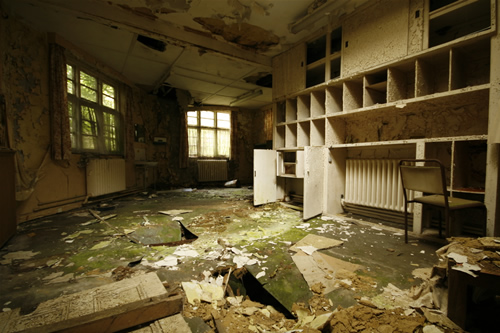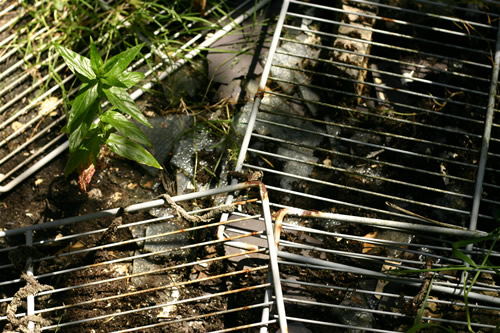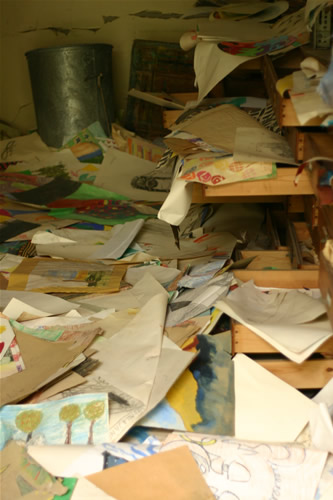The central and service areas differed greatly in their condition. Administration was used after closure as the security guards office, but this use ceased in the late ’90s. The Main Hall had been destroyed by fire in 2002, but the Chapel remained in reasonable condition, bar vandalism to the organ. The kitchens were largely destroyed by fire as well, but some parts remained. The Water Tower was accessible in mid 2008 and offered great views of the site.
Facilities around the Administration Block

Patients Bank


Pharmacy Bottles, Magazine rack in library

Staff rest room


Dentists, drawer in records room

Post office
 Housing Office
Housing Office
Chapel


View from rear, detail of arch
 The Altar
The Altar


Detail of Altar, View from rear entrance
 Side View from Browning
Side View from Browning
Main Hall
The Hall was destroyed in a fire in 2002. From the architect’s plans it would have had an arched roof, and there were entrances at either side of the room for access from both the male and female sides. There was a serving hatch from the kitchen
The stage was on the Female side, and the balcony and projectors booth on the male.
 From the entrance to the balcony
From the entrance to the balcony


Looking at the Chapel, Record players which survived the fire
 Onû the roof of the Projection room
Onû the roof of the Projection room
Kitchens/Cafeteria
A large room with all it’s equipment removed.
 Entrance on Male Side
Entrance on Male Side



Cafeteria opposite Alleyn Ward.


Laundry




 Yard behind laundry
Yard behind laundry
Art Room






Mortuary



Water Tower




Boiler House
 Viewed from the water tower
Viewed from the water tower
 Hot Water Tanks
Hot Water Tanks
 Boilers
Boilers
 Control Panel
Control Panel

If one was to look at the history of Cane Hill’s end days from the photos of the explorers, from some of the first exploreres C.O.W.A.R.D. experience in 1998 through to Urbex, and later groups you can see a procession of items missing. The insides of the radiators were stolen by 2005. Other things go missing, mirrors, telephones, all souveniers etc.
When Cane Hill was closed nothing was saved, and there were medical, electrical, plumbing supplies, tools and trolleys. All these institions used copper clad cables, and what Squibbs can get out of reclaiming stuff would be enough to pay for the demolition. I heard that they were re-cycling 2 million Victorian bricks!
If you look up and down the country at all the Mental hositals that were closed and pulled down and houses built, I wondered what happened to all that money when the land was sold off?
Peter
Cane Hill was unique in that sense, being such an early closure – Once local authorities realised these complexes weren’t going to serve another purpose, and costs of securing over a number of years would cost more than demolition and subsequent land sales, they were quick to clear them out and either convert or demolish them. Despite the many proposals for use, none obviously came to fruition and that is why it was such a treasure trove for explorers.
I imagine the bricks from Cane Hill have been sold to developers across the country and many new build houses will have a little of Cane Hill in them?
It’s such a shame, and I think future generations will really lament how easily this massive part of British history (both Cane Hill and the asylum system in general) has just been swept under the carpet in yet another example of a transferral of public money into private pockets.
The lack of proper documentation is also tragic and means that in numerous cases, “urban explorers” and enthusiasts have been the only people to provide any significant record at all – mainly because local authorities didn’t/don’t want the general public thinking too hard about all that waste, or asking too many questions about the flow of money in relation to these places.
Also find me here: http://anotherstateofmind.zenfolio.com/
Fantastic site by the way, keep it up!
Such a sad sight to see. I drove up Portnalls Road yesterday and through the trees where once I saw the delapidated majesty of Cane Hill all that’s left now is the chapel and the admin block. I wish a book could be published all about Cane Hill’s history. Keep up the good work with the website.
Thanks for the kind words. Maybe one day there’ll be a book, but I’ve found myself working hard on other projects in the last year or so.
:~* I am really thankful to this topic because it really gives great information *;,